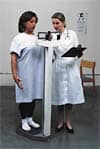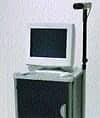An obese 26-year-old female diagnosed with severe OSA, benefitted from a combination of gastric bypass surgery and CPAP.

She also had a total of 28 hypopneas, the longest of which lasted 36 seconds. Her apnea/hypopnea index was 52.4 and she was evaluated as having severe obstructive sleep apnea (OSA) syndrome. The lowest oxygen saturation that was recorded was 72.7%. At l:06 am she began to use nasal continuous positive airway pressure (CPAP), which was eventually titrated to a bilevel setting of 17 cm H2O for inspiration and 14 cm H2O for expiration. This pressure setting appeared to resolve her sleep-disordered breathing completely.
The patient returned to the center again on September 20, 1999, after having successfully undergoing Roux-en-Y gastric bypass surgery and registering a weight loss of 65 kg. Her BMI was 48. She spent 10% of her sleep time in stage 1, 65% in stage 2, 7% in stage 3, and 18% in REM. Her previous bilevel settings were discarded and she was studied using CPAP at a level of 4 cm H2O.
In response to continued evidence of sleep-disordered breathing, her CPAP level was titrated to 9 cm H2O. Her overall apnea/hypopnea index on CPAP was 5.2 events per hour. The lowest oxygen saturation that was recorded was 94%.
She returned again for a post-weight-loss study on March 27, 2000. She then weighed 126 kg (representing a loss of 78 kg) with a BMI of 45. She complained that her CPAP pressure of 9 cm H2O was too high. A split-night study was performed to rule out continued sleep apnea and perform CPAP titration, if necessary. During the first 2 hours of the study, she had 19 apneas with a mean duration of 17.3 seconds and maximum duration of 32.7 seconds. There were 69 hypopneas with a mean duration of 19.8 seconds and a maximum duration of 39.1 seconds. The apnea/hypopnea index was 50.3 events per hour. Beginning at 1:36 am, she began to use CPAP with an initial pressure of 4 cm H2O. This was titrated upward (in response to evidence of continued sleep-disordered breathing) to a level of 6 cm H2O. The overall apnea/hypopnea index at that setting was 0 events per hour.
Discussion
This case history confirms that weight loss from a very high starting level can reduce the severity of OSA, but may not completely eliminate it. Conversely, excessive weight seems to contribute to an increase in the severity of OSA. That the severity of this patient’s OSA was lessened by weight loss is demonstrated by the progressive decrease in pressure required to completely eliminate sleep-disordered breathing.
The incidence of OSA is reported at about 6% of the US population1 overall, with obesity being suggested as a strong predictor of its presence. In obese individuals, OSA has been reported in up to 40% of cases studied,2 and in one large series,1 BMI more than one standard deviation above norm was associated with a threefold increase in the risk of OSA. Data from extremely obese individuals presenting for preoperative evaluation for gastric bypass surgery indicate an OSA prevalence rate of 85%.3 To date, however, there have been few follow-up studies on the effect of weight loss on OSA.
One of these, by Strobel and Rosen,4 demonstrates that mild-to-moderate reductions in weight improve upper-airway function during sleep and lessen the severity of OSA as a consequence.
Conclusion
We conclude from this case history and from a larger series of similar cases that all patients being considered for gastric bypass surgery who have the indication for what is morbid obesity should be studied in the sleep laboratory and, if necessary, titrated onto CPAP. We believe that all such patients should be extubated onto CPAP during the post anesthesia recovery period until they are fully alert.
Thomas Kilkenny, DO, FAASM, is medical director, Sleep Apnea Center, Staten Island University Hospital, Staten Island, NY, and Steve Grenard, RRT, is clinical coordinator of the center.
Acknowledgements
The authors wish to acknowledge the following members of the Sleep Apnea Center staff for their participation in the diagnosis and management of this case: Linda Cannelis, RRT, RPSGT; Jeanne DePalo, PSGT; Thomas Flattery, RRT, RPSGT; Peter DeCesare, RRT; and Betty Sendzishew, RRT.
References
1. Young T, Palta M, Dempsey J, Skatrud J, Weber S, Badr S. The occurrence of sleep-disordered breathing among middle-aged adults. New Engl J Med. 1993;328:1230-1235.
2. Vgontzas A, Tan T, Bixler E, Martin L, Schubert D, Kales A. Sleep apnea and sleep disruption in obese patients. Arch Intern Med. 1994;154:1705-1711.
3. Kuczmarski RJ, Flegal KM, Cambell SM, Johnson CL. Increasing prevalence of overweight among US adults. JAMA. 1994;272:205-211.
4. Strobel RL, Rosen RC. Obesity and weight loss in obstructive sleep apnea: a critical review. Sleep. 1996;19:104-115.




